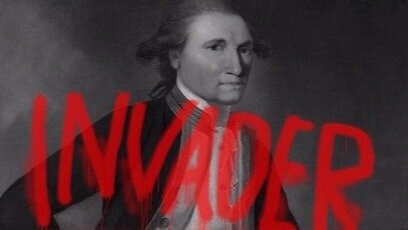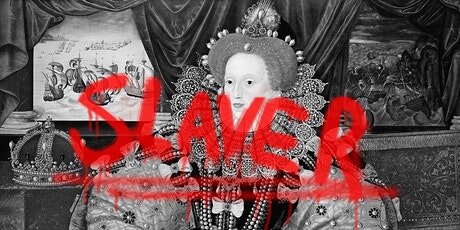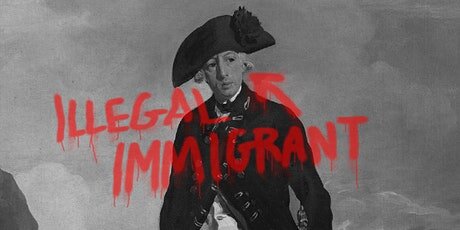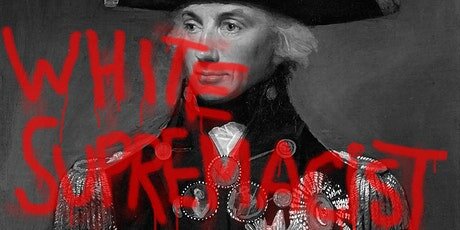Mannalargenna - An Aboriginal Warrior or Misogynist Slaver? The Unintended Consequences of Re-Writing History
In recent years, the memory and achievements of the Tasmanian Aboriginal warrior, Mannalargenna, have begun to be more widely and prominently recognised - see here. And fair enough - it is a good thing for Tasmanians, and indeed Australians in general, to learn about, understand and appreciate Mannalargenna’s place in our history.
However, a ‘revolution’ is brewing around the Western world, particularly in the English-speaking countries and a ‘mob’ has been unleashed in a furious backlash against our colonial past. The mob’s fury, driven by the ‘Activists of Colour’ and others on the Progressive Left, manifests itself with attacks against the memories, exploits and statues of colonial explorers such as Captain Cook, slave owning businessmen such as James Colston and Empire builders such as Cecil Rhodes, not to mention more numerous anti-slavery examples in the US.
The attacks on Cecil Rhodes’ statues are particularly perplexing given that some of the strongest critics of Rhodes’ legacy are, you guessed it, ‘people of colour’ on Rhodes Scholarships at Oxford University (here and here and here ) - talk about hypocrisy and biting the hand that feeds you!
Another rising member of the ‘revisionist mob’ is expatriate Australian, art historian, Alice Procter, who operates the, ‘Uncomfortable Art Tours’ of museums and galleries in London, and who wants us to explore,
‘The history of British art [as a] history of empire and genocide, written by collectors who traded in landscapes and lives.’
One of Ms Procter’s recent tweets in response to the Prime Minister Scott Morrison’s comments in the latest ‘history wars’ debate, gives one an idea of Procter’s political leanings,
‘yes, the PM is a vain and self-serving person, a dishonest and vindictive politician, and a racist, but at least he has the decency to also be a terrible historian’;
as does this film clip, of where Procter tries to explain how she believes we should face-up to the ‘imperial legacies’ we are all ‘profiting’ from.
For dramatic effect to advertise her tours, Procter has doctored various images of famous figures from our history with words that she hopes will challenge us to question our understanding of our historical past, and to help us ‘check our privilege’ and think about what we have inherited.
Photograph credits : The Exhibitionist
One of the problems with a ‘revolutionary mob’ in the service of a Progressive and Noble cause is the potential for its leaders and ‘darlings’ to ultimately lose control, or adoration, and be devoured themselves by the mob as it moves onto new Progressive ideals.
Within the Australian historical context, writers such as Bruce Pascoe are pushing a more Progressive Left narrative, which involves denigrating Colonial Australia and elevating the supposed virtues of Aboriginal Australia.
For example, Mr Pascoe was guest of honour to discuss his book, Dark Emu, at Mannalargenna Day in 2018, which is ‘a cultural celebration for the North-East’s First Nations people in honour of 19th century warrior, Mannalargenna’. The event has official recognition by being opened by the Governor of Tasmania, Kate Warner.
You can hear Mr Pascoe talking here on the ABC ahead of his visit to Tasmania for Mannalargenna Day celebrations.
To an outside observer however, there is something a little problematic about celebrating the achievements of Mannalargenna, without perhaps first providing a disclaimer, or some balancing details, on his not-so-favourable achievements, which included being quite a successful kidnapper and ‘slave-trader’ of Aboriginal Tasmanian women, including his own daughters and sister, as explained below.
And this is especially pertinent, given that Mr Pascoe himself has been very outspoken about, what he says, was the ‘slavery’ of the Aboriginal people during Colonial times - see here and here on the ABC.
We predict that the ’anti-woman’ practices of Mannalargenna will come in for quite a battering over the next few years as the ‘revolutionary mob’, especially the fourth-wave feminists, who will ultimately morph into their ‘fifth-wave’, move onto their next targets and start to pass a critical and deconstructionist eye over Mannalargenna’s historical records,
Can we expect to see ‘anti-male violence’ and ‘sex-slaver’ graffiti on Mannalargenna’s memorial?
Probably, because there are records of Mannalargenna’s deeds, some of which have already been published by ‘leading academic on Aboriginal, Australian and Feminist history, Professor Lyndall Ryan' in her book, The Aboriginal Tasmanians. She describes the first contact of sealers, who came from Sydney, the United States and Britain and started arriving on the North coast of Tasmania from 1804, with the local Aboriginal peoples, especially the Tasmanian warrior Mannalargenna. She writes,
Leading academic on Aboriginal, Australian and Feminist history, Professor Lyndall Ryan
“[The sealers] visits coincided with the Aborigines’ summer pilgrimage to the coast for muttonbirds, seals, shellfish, and birds and their eggs. Most Aboriginal groups were at first cautious of these visitors, but it was not long before they were willing to exchange seal and kangaroo skins for tobacco, flour, and tea. This contact intensified when the Aborigines offered women in an attempt to incorporate the visitors into their own society. When the sealers reciprocated by offering dogs, the means were provided for mutually advantageous interaction. By 1810 the North East people had begun to gather each November at strategic points along the north-east coast…in anticipation of the sealers’ arrival. After their appearance, usually in a whaleboat containing four to six men, a dance would be held, a conference would take place, and an arrangement would be made for a number of women to accompany the sealers for the season. Some women came from the host band, while others were abducted from other bands and sold to the sealers for dogs, muttonbirds, and flour...Once the economic value of Aboriginal women in catching seals was exploited by the sealers, the economy and society of the North East [Aboriginal] people changed. They now remained on the coast for the whole summer instead of moving inland to hunt kangaroos. In winter they [the Aborigines] went in search of other bands and tribes along the coast to abduct their women.
The power and influence of individual leaders like Mannalargenna…also increased. He led many raids for women on other bands, negotiated with sealers, and quickly saw the value of European dogs to the Aboriginal economy and gift exchange system.”
- Professor Lyndall Ryan, The Aboriginal Tasmanians (UQP, 1981, 1982 reprint, p69 – 71) - our emphasis.
ps: One wonders whether the Progressive ‘thought-police’ are already onto Professor Ryan, given that the text relating to the abduction of Aboriginal women by Aborigines, and to Mannalargenna and his raiding parties, has been omitted in the second edition of Professor Ryan’s book, now entitled, Tasmanian Aborigines - A history since 1803, Allen & Unwin, 2012. Instead, one new sentence has been inserted in the new edition,
“But in the North West nation, the sealers were known to kidnap women for permanent habitation on the western Bass Strait Islands” - (ibid., p59),
which plays into the new history re-writing narratives, a la Bruce Pascoe and Dark Emu - Colonial settlers and sealers always bad - Aborigines always good (or not so bad).
Writer and Aboriginal historian Patsy Cameron - a direct descendent of Mannalargenna - Source
Robert DOWLING - Aborigines of Tasmania 1859 Queen Victoria Museum and Art Gallery, Launceston. Manalargenna converses with other seated Aborigines.
Some Tyrerelore spent their final years at Oyster Cove, Van Diemen's Land. Middle row, second from left is Flora/Pelloneneminner and reclining, second from right, is Emma/Emue.- Source
Writer and Aboriginal historian Patsy Cameron, who is a direct descendent of Mannalargenna, has written a wonderful and seemingly erudite book, Grease and Ochre (Fuller’s Bookshop, 2nd ed. 2016) where she details the trading of Tasmanian Aboriginal clanswomen (the tyereelore) with the sealers, in exchange for dogs, seal carcasses, flour and other goods.
Cameron writes,
‘…it was at the behest of the clan bungunnas [leaders] such as Mannalargenna that these exchanges took place and they took shared responsibility for the social consequences of these arrangements, especially as the need for additional clanswomen rapidly increased …to support the feather industry [on the islands]’.
-(ibid., p100-101)
Cameron then surmises that,
‘Initially the Straitsmen [sealers] must have bargained to acquire the most culturally valuable and desirable females, and indeed a bungunna’s daughter must have met both these qualities.
Mannalargenna was an esteemed bungunna who was held in the greatest regard by the trouwunnan [Tasmanian] clans and nations who knew of him. Since he exchanged at least three of his four daughters and a sister with the eastern Straitsmen…exploring his motivation for allowing his daughters to live in the [sealers] islands is particularly significant.'
Cameron then ‘explores’ possibilities for Mannalargenna’s motivations such as a ‘strategy to directly bond with the Straitsmen’ [perhaps like the cassare used by West African slave suppliers and rulers to bond, via marriages, with the European slavers?] which would be expected to give Mannalargenna relatively more power, prestige and wealth. Or alternatively, Cameron suggests he did it to remove his daughters and sister to a remote island, as it was a safer location given the conflicts and loss of life occurring in Tasmania at the time.
Now, to a Progressive, ‘fifth-wave’ feminist of the future, a father, who seeks personal gain by selling off his daughters into ‘sexual slavery’, and forcing them to work for crude, low-life, animal killing sealers, is not a good look. Mannalargenna’s actions may be viewed in the future as being ‘problematic’, and his currently high reputation may be difficult to maintain.
Already the mood is moving against any historical figures who have a history of being involved in the abduction, or trading, of Aboriginal women, as ‘Tasmanian Aboriginal’ man, Bruce Pascoe has pointed out,
“Sealers abduct Aboriginal women, a practice repeated frequently wherever sealers plied their trade’
- Pascoe, B., Convincing Ground, Aboriginal Studies Press, 2007, p267
And the future for Mannalargenna’s legacy?
- An Aboriginal Warrior, or Misogynist Slaver who sold his daughters and sister into servitude?
It may be hard to imagine today, but there may too come a time when this plaque commemorating Mannalargenna is defaced with ‘slaver’ graffiti by the history-revision activists of the future.
Who indeed, would have thought that a memorial statue to Winston Churchill, who saved Britain from the horrors of Fascism, would need police protection in 2020 to prevent defacement by members of the British public.
And similarly for that most Enlightened of men, Captain Cook, with his statue in Hyde Park, Sydney being daubed with the graffiti, ‘there is no pride in genocide’.
Who would have thought.















